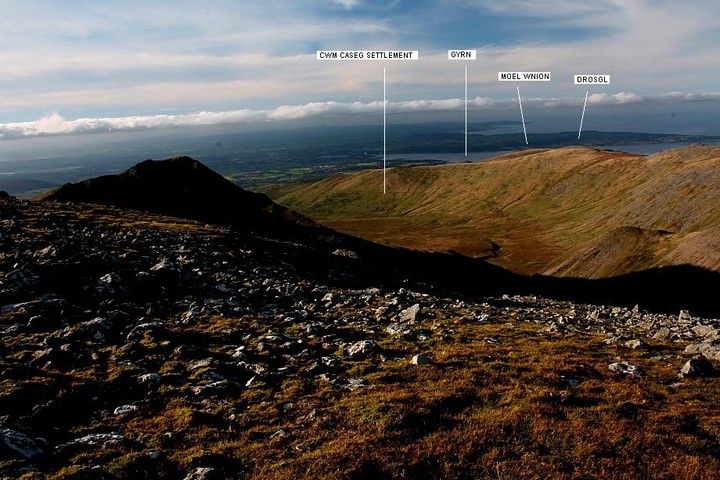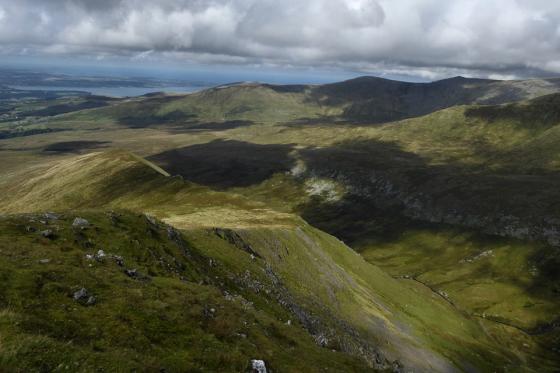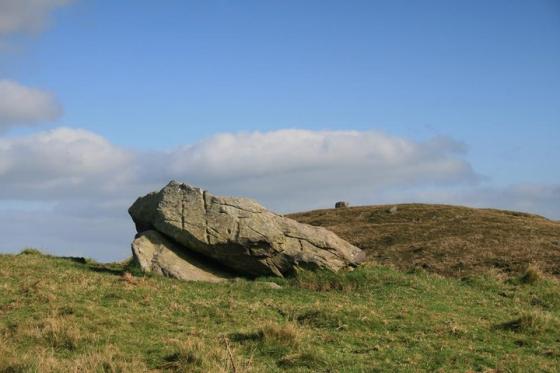Pumlumon... and the Cwmdeuddwr Hills rising above Elan... may well share the distinction of forming Wales’ true wilderness, Y Rhinogydd that of possessing, arguably, her roughest, most uncompromising terrain... but I reckon Y Carneddau is the premier mountain group in the land, all things considered. Its summits also play host to Wales’ – if not the UK’s (?) – most extremely sited Bronze Age cemetery. It is a potent combination, providing all the more reason for the megalithically-minded traveller to pay a visit, in search of that psychological ‘essence’ which prompted our ancestors to intern their VIP dead in such places. If it is indeed retained somewhere in the modern psyche, where better to unlock the mind?
Perhaps it is no coincidence that, like Pumlumon, Wales’ other – and to my mind finest – great upland Bronze Age cemetery, Y Carneddau does not advertise its attributes to the passer by.... the soaring crags, deep rocky cwms, isolated mountain tarns – even Yr Elen, the crown jewel – are all cradled within, hidden from the prying eyes of the casual tourist. Yeah, one has to actually walk the great whaleback ridges to discover what lies between. Consequently it is the brash Glyderau, the incomparable bravado of Tryfan to the fore, and Snowdon (Itself) which grab the attention and the plaudits, Y Carneddau remaining a mysterious, secret land, an unknown quantity to all but those who don the boots. The ‘lost world’ aura is all too often accentuated by the mist which rolls, unhindered, across the high, domed tops. At times like these it is advisable to keep well away... for route finding becomes a very serious business indeed.
So, what of the ancient cairns which crown a significant number of the Carneddau’s high summits? Arguably the finest, albeit restored following excavation, is that upon Drosgl to the north. However the monument which stands upon the brutal, windswept, 3,196ft summit of Foel Grach is perhaps not only the hardest to reach, but also that which – for me – best embodies the primeval ‘essence’ alluded to earlier, that which maybe invokes the instinctive ‘intuition’ signifying that here is the perfect location to perhaps enter an altered state of consciousness, to use parts of the brain not normally utilised in order to attempt to perceive something out of the ordinary. Whether this is due to shortness of breath, reduced oxygen levels, sheer fatigue, autosuggestion.... wishful thinking, even... I cannot say? What I can say is that these places affect me. Deeply.
Although approaching something like 2m in height, the great Foel Grach cairn does not dominate its surroundings like other such monuments. The scale of the latter is perhaps too great, the eye drawn across the boulder-strewn summit plateau to the striking Yr Elen across Cwm Caseg to the west.... and towards the Menai Straits, sparkling beyond the be-cairned northern ridge of Y Carneddau to the approx north-east. To the east, the cliff line of Craig y Dulyn conceals a pair of reservoirs at its foot, two of the darkest, most secretive pools of water in all Wales, the valley of the Afon Conwy and the Great Orme crowning the skyline. To the north-west there is an uninterrupted view towards an ancient settlement sited below Gryn Wigau.... the former inhabitants perhaps the people who erected this monument.... although, admittedly, there is another such settlement below to the east at Pant-y-Griafolen? Finally, Carnedd Llewleyn, summit peak of Y Carneddau rises to the south bearing the highest surviving monument in Wales. Jeez, this is some spot. If insight can be forthcoming, ‘tis the place alright. Whether the individual can make any sense of what he feels today... is another matter entirely.
Perhaps the most straightforward route to visit the Foel Grach cairn is to start from the small car park north of Llyn Eigiau and follow Cefn Tal-llyn-Eigiau to the col between the peak and Carnedd Llewelyn. A well graded, green track affords a good beginning, the traveller gaining the ridge by way of an obscure path just beyond a ladder stile. Alternatively stick with the green track all the way to Melynllyn, ascending direct to the summit to the right of the lake, although admittedly very steeply. I took the latter option this time, carrying on to Carnedd Llewleyn and returning via Cefn Tal-llyn-Eigiau. It is also possible to descend from Carnedd Llewelyn – incidentally via Tristan’s Cairn – to Pen-yr-Helgi-Du and Pen Llithrig-y-Wrach (the latter also crowned by a Bronze Age cairn), so completing the high level circuit of Cwm Eigiau. However at some 11 miles, this is a serious walk indeed. Check the map... there are other options, too.






























































































































































































































